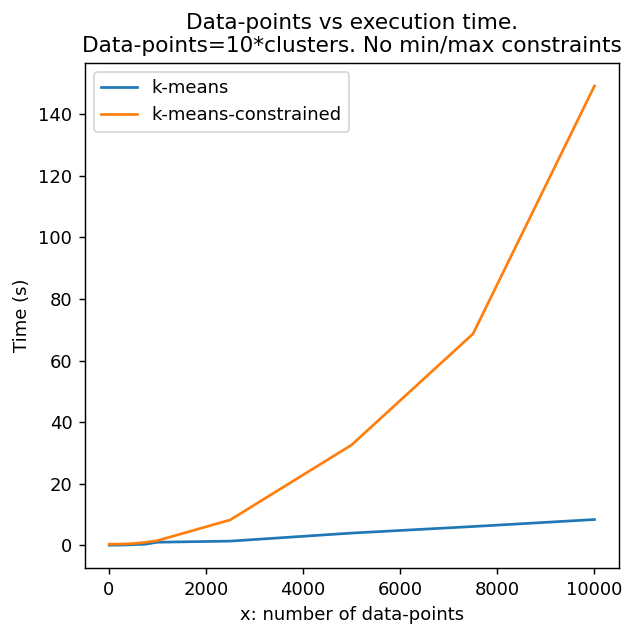K-means clustering implementation whereby a minimum and/or maximum size for each cluster can be specified.
This K-means implementation modifies the cluster assignment step (E in EM)
by formulating it as a Minimum Cost Flow (MCF) linear network
optimisation problem. This is then solved using a cost-scaling
push-relabel algorithm and uses Google's Operations Research tools's
SimpleMinCostFlow
which is a fast C++ implementation.
This package is inspired by Bradley et al.. The original Minimum Cost Flow (MCF) network proposed by Bradley et al. has been modified so maximum cluster sizes can also be specified along with minimum cluster size.
The code is based on scikit-lean's KMeans
and implements the same API with modifications.
Ref:
- Bradley, P. S., K. P. Bennett, and Ayhan Demiriz. "Constrained k-means clustering." Microsoft Research, Redmond (2000): 1-8.
- Google's SimpleMinCostFlow C++ implementation
You can install the k-means-constrained from PyPI:
pip install k-means-constrained
It is supported on Python 3.8 and above.
More details can be found in the API documentation.
>>> from k_means_constrained import KMeansConstrained
>>> import numpy as np
>>> X = np.array([[1, 2], [1, 4], [1, 0],
... [4, 2], [4, 4], [4, 0]])
>>> clf = KMeansConstrained(
... n_clusters=2,
... size_min=2,
... size_max=5,
... random_state=0
... )
>>> clf.fit_predict(X)
array([0, 0, 0, 1, 1, 1], dtype=int32)
>>> clf.cluster_centers_
array([[ 1., 2.],
[ 4., 2.]])
>>> clf.labels_
array([0, 0, 0, 1, 1, 1], dtype=int32)Code only
from k_means_constrained import KMeansConstrained
import numpy as np
X = np.array([[1, 2], [1, 4], [1, 0],
[4, 2], [4, 4], [4, 0]])
clf = KMeansConstrained(
n_clusters=2,
size_min=2,
size_max=5,
random_state=0
)
clf.fit_predict(X)
clf.cluster_centers_
clf.labels_
k-means-constrained is a more complex algorithm than vanilla k-means and therefore will take longer to execute and has worse scaling characteristics.
Given a number of data points
- k-means:
$\mathcal{O}(nc)$ - k-means-constrained1:
$\mathcal{O}((n^3c+n^2c^2+nc^3)\log(n+c)))$
This assumes a constant number of algorithm iterations and data-point features/dimensions.
If you consider the case where
- k-means:
$\mathcal{O}(n^2)$ - k-means-constrained1:
$\mathcal{O}(n^4\log(n)))$
Below is a runtime comparison between k-means and k-means-constrained whereby the number of iterations, initializations, multi-process pool size and dimension size are fixed. The number of clusters is also always one-tenth the number of data points
System details
- OS: Linux-5.15.0-75-generic-x86_64-with-glibc2.35
- CPU: AMD EPYC 7763 64-Core Processor
- CPU cores: 120
- k-means-constrained version: 0.7.3
- numpy version: 1.24.2
- scipy version: 1.11.1
- ortools version: 9.6.2534
- joblib version: 1.3.1
- sklearn version: 1.3.0
1: Ortools states the time complexity of their cost-scaling push-relabel algorithm for the min-cost flow problem as
If you use this software in your research, please use the following citation:
@software{Levy-Kramer_k-means-constrained_2018,
author = {Levy-Kramer, Josh},
month = apr,
title = {{k-means-constrained}},
url = {https://github.com/joshlk/k-means-constrained},
year = {2018}
}


